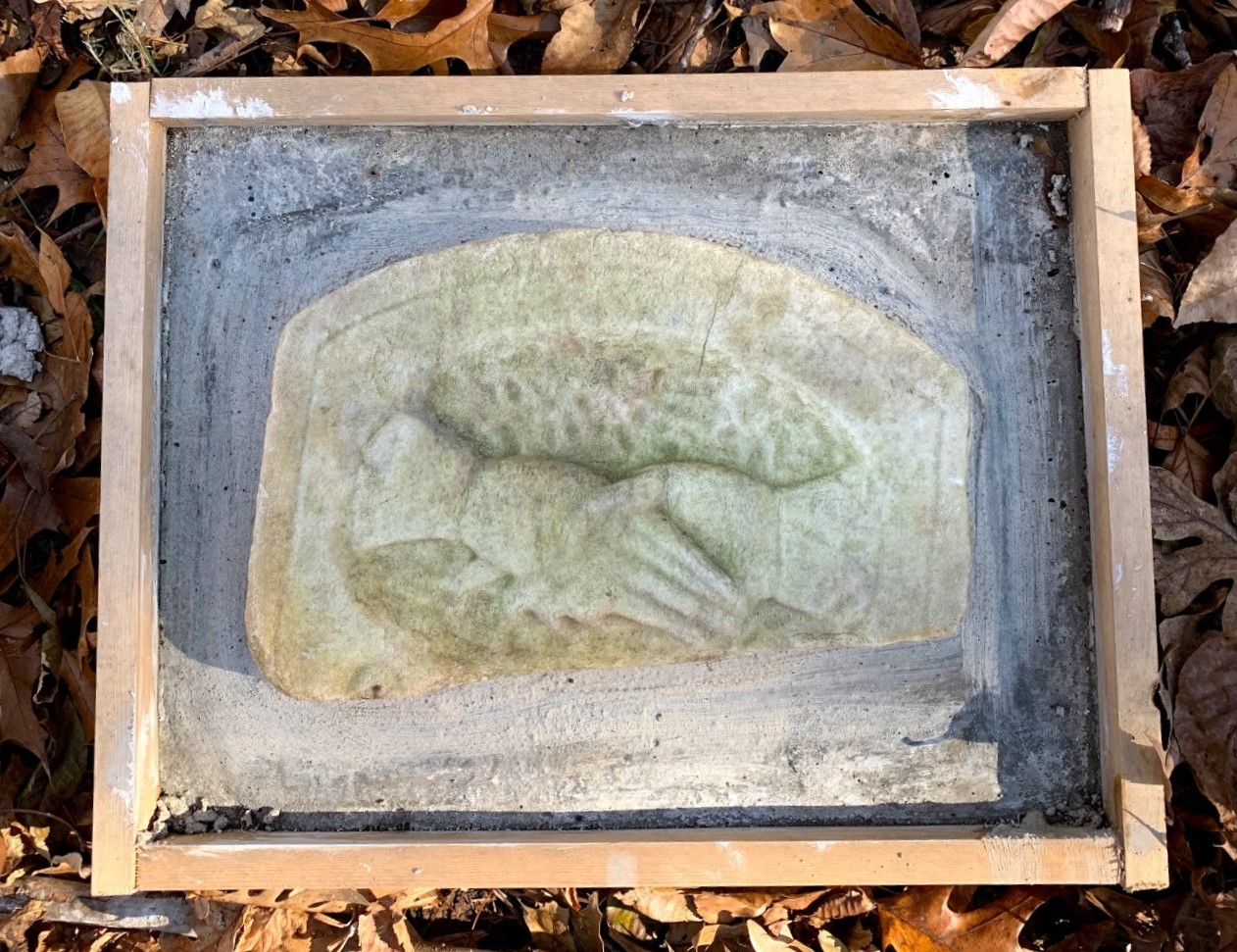The Union Campground Cemetery, located in the woods of northern Greene County, Missouri, was in use from 1840 to 1920. The cemetery fell into disuse after 1920, but it was rediscovered in 1992 by descendants of the people buried there; it is now maintained by the Union Campground Cemetery Association, and the cemetery continues to be visited by the descendants as well as interested members of the regional community.
The Union Campground Cemetery is an important part of local history. Although the cemetery is named for its Union activity during the Civil War, the cemetery predates the war; the cemetery was also used as a religious revival campground. Of particular interest is how the cemetery is also an early example of integrated cemeteries in this region, with burials of the local Caucasian community throughout its history as well as of slaves before the war and of freed slaves and free Black people after the war.
The gravestones in the Union Campground Cemetery take a wide variety of shapes and are made in a variety of materials. In the 19th century, limestone and sandstone were popular choices of local stone for Missouri gravestones, and the gravestones are typically all hand-cut and hand-carved. The bedding lines in the sandstone gravestones are still visible. Marble is less common as a gravestone, as this stone is not native to the state and had to be imported; marble gravestones therefore reflect either the substantial wealth of the family or the funding available to them at the time. Headstone shapes are also influenced by the financial resources of the family, as well as the social status of the deceased’s family within the community.
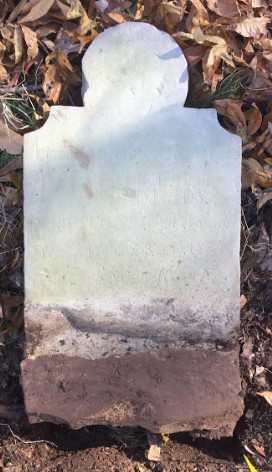
Headstone of Josephine Deeds
American Midwest culture
1844
Sandstone, L. 39 cm x W. 8.5 cm x H. 54 cm
Union Campground Cemetery #18
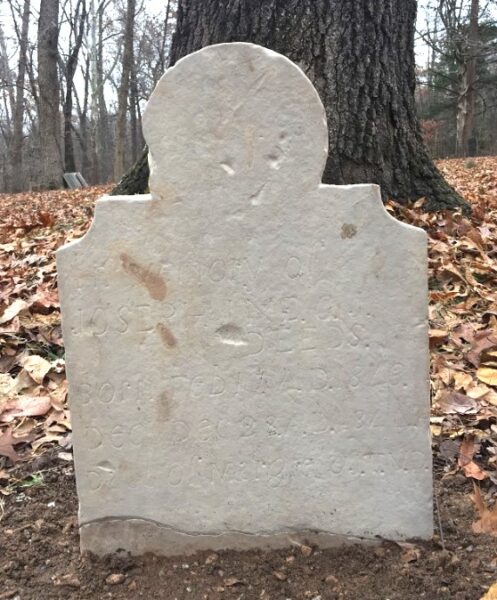
Headstone of Josephine Deeds
American Midwest culture
1844
Sandstone, L. 39 cm x W. 8.5 cm x H. 54 cm
Union Campground Cemetery #18
This headstone belongs to Josephine Deeds, who died in 1844 at less than two years old. The inscription on her headstones names her parents as Margret and J. T. V. D. Unlike many infant headstones, Josephine’s headstone is the same size as adult headstones in the cemetery. As was common practice in the mid-19th century, Deed’s headstone was not only hand-cut and hand-carved, but hand-lettered. Deeds’s headstone also takes an elaborate three-lobed shape on top with concave indentations on each side; this type of gravestone was called a tympanum top with scotia shoulders. (Researched by Rebecca Prado)
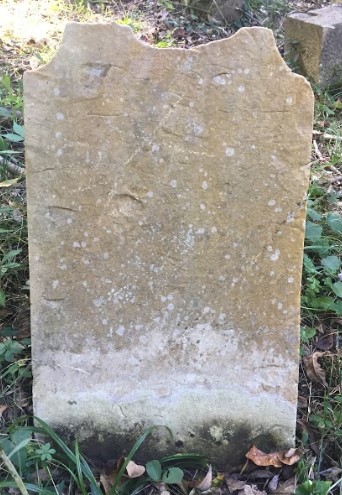
Headstone of Columbus B. Freeman
American Midwest culture
1852
Sandstone, L. 31 cm x W. 5 cm x H. 51 cm
Union Campground Cemetery #45
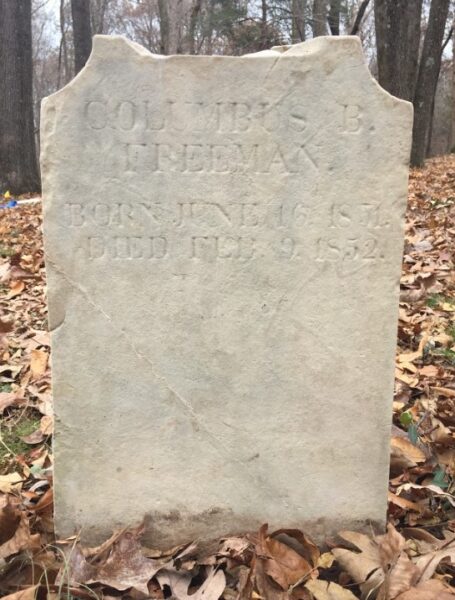
Headstone of Columbus B. Freeman
American Midwest culture
1852
Sandstone, L. 31 cm x W. 5 cm x H. 51 cm
Union Campground Cemetery #45
The Columbus Bell Freeman headstone was carved in 1852 for a young member of the Freeman family who died at less than a year old. Columbus Freeman is the son of George W. Freeman and Elizabeth G. (Snow) Freeman, both of whom are buried in the cemetery near Columbus’ grave; the headstone of George is missing, but records indicate his burial in the cemetery. The Columbus Bell Freeman headstone size is also unusual, as most headstones for infants are smaller than typical adult headstones. This headstone, however, is the same, full-sized headstone as for the other family members’ headstones located in the cemetery.
The headstones of many members of the Freeman family in the Union Campground Cemetery are shaped similarly to the Josephine Deeds’s headstone. This, along with the scotia shoulders of the broken top section of Columbus B. Freeman’s gravestone, indicates that Columbus’s headstone also likely took the form of a tympanum top with scotia shoulders. (Researched by Rebecca Prado)
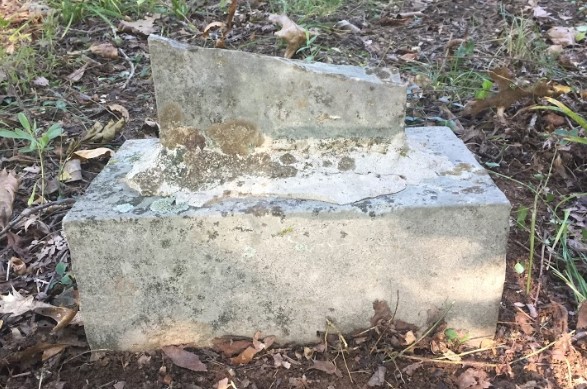
Fragmentary Headstone of William B. Freeman
Midwest America culture
1862
Limestone, L. 34 cm x W. 20.5 cm x H. 13 cm
Union Campground Cemetery #13a
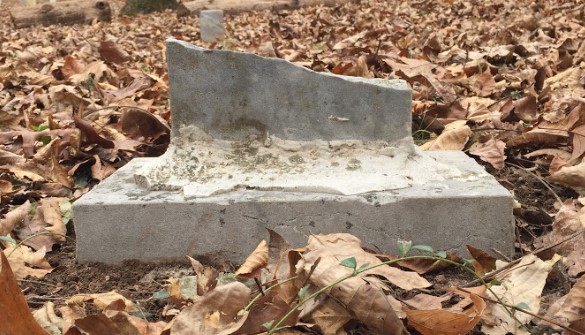
Fragmentary Headstone of William B. Freeman
Midwest America culture
1862
Limestone, L. 34 cm x W. 20.5 cm x H. 13 cm
Union Campground Cemetery #13a
This headstone likely belongs to William B. Freeman, who died in 1862 at 37 years old. Although the top of the gravestone is broken away, the position of the gravestone indicates that this is Freeman’s grave; this identification is further supported by a footstone found nearby that is engraved with the initials “W. B. F.” Buried in Union Campground Cemetery along with William’s infant daughter, brothers, parents, sister-in-law, and nephews, Freeman has the only family headstone that was set within a base. Freeman’s headstone was carved from limestone, and the straight sides, size, and thickness indicate that it likely originally took the same shape as the Mary Looney headstone in the same cemetery, which is tall with a round top, and which is also mounted in a base. (Researched by Rebecca Prado)

Midwest America culture
1862
Limestone, L. 11.5 cm x W. 5 cm x H. 12 cm
Union Campground Cemetery #13b
The footstone marked “W. J.” is possibly the footstone of Warren Jones, who was buried in the Union Campground Cemetery. This footstone is made of limestone and takes a simple, classic, tablet shape. (Researched by Rebecca Prado)
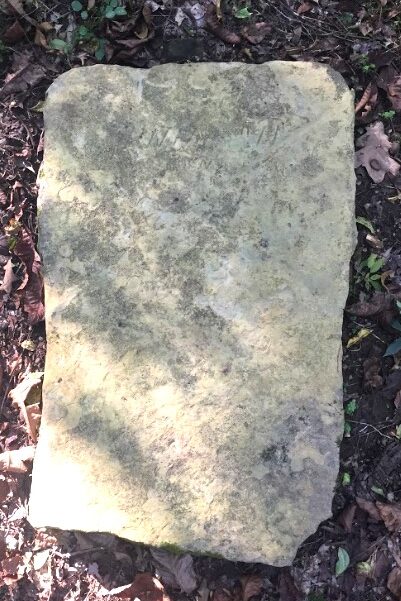
Gravestone of Fanny Sims
Midwest America culture
19th Century
Limestone, L. 57 cm x W. 10 cm x H. 91 cm
Union Campground Cemetery #5
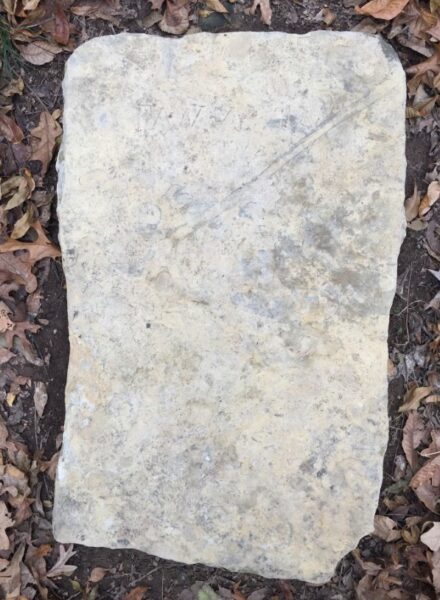
Gravestone of Fanny Sims
Midwest America culture
19th Century
Limestone, L. 57 cm x W. 10 cm x H. 91 cm
Union Campground Cemetery #5
This is the gravestone of Fanny Sims, also known as “Widow Sims,” who died in 1849 at 71 years old. She was born in North Carolina and moved to Tennessee with her husband, Briggs Sims; when he died in 1832, she moved with her family to Greene County, Missouri. Since no other family members are known to be buried in the cemetery, Sims may have been the first or only member of her family to pass away in Greene County.
Unlike most of the other headstones in this cemetery, Sims’ gravestone is a ledger stone, which is designed to lay flat on top of the grave. Ledger stones, also known as body slabs, lay above the grave as if a lid on a coffin; these stones may originate from the practice of placing in cairns, or piles of rocks, over graves to prevent scavengers from digging up shallowly buried bodies. Later, large slabs of stone were cut and placed on graves, possibly because of the belief that this would prevent the body from rising from the grave. Sims’s gravestone was hand-cut from limestone with hand-cut lettering; unfortunately, the flat position of the gravestone has resulted in the erosion of the inscription, which is gradually disappearing. (Researched by Rebecca Prado)
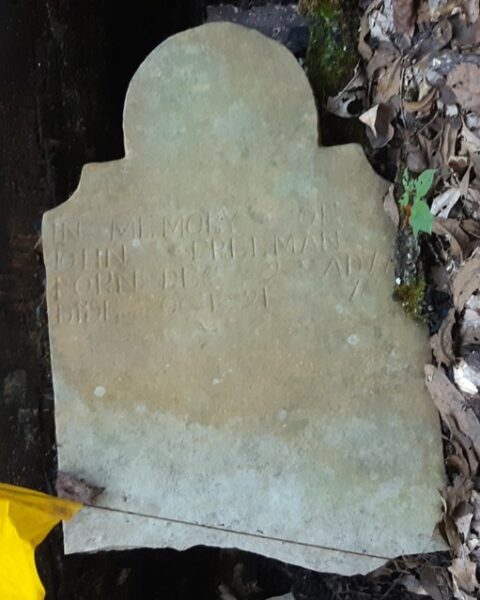
John Freeman Headstone
American Midwest culture
19th century
Limestone, L. 35 cm x W. 5.1 cm x H 48.2 cm
Union Campground Cemetery #14
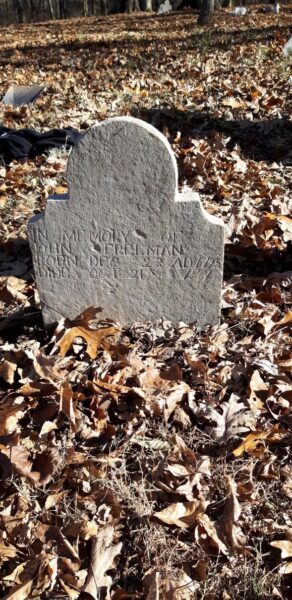
John Freeman Headstone
American Midwest culture
19th century
Limestone, L. 35 cm x W. 5.1 cm x H 48.2 cm
Union Campground Cemetery #14
This headstone memorializes John Freeman, who was born in 1796 and passed away in 1861. John was born in North Carolina, and in 1815, he married Lavica Williams; he and Lavica later moved to Missouri, and she is also buried in this cemetery.
John’s headstone is made of limestone, and it has hand-engraved lettering. During the 19th century, headstone carvers were commonly illiterate and only copied the texts that were presented to them; they often misspelled words or ran words together. This is clearly the case Freeman’s gravestone, as the word “DIDE” was inscribed instead of “DIED.” (Researched by Ashley Pitt)
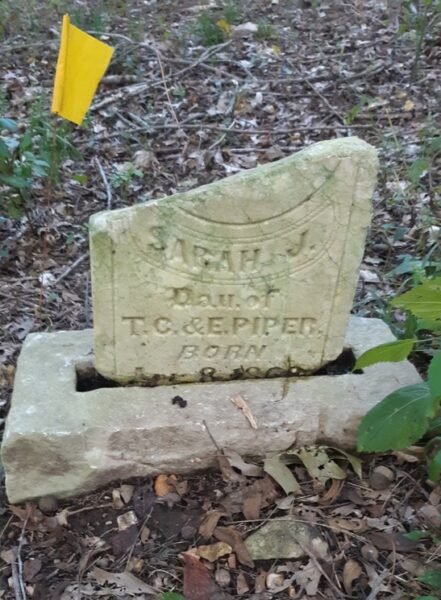
Sarah J. Piper Headstone
American Midwest culture
19th century
Marble, L. 30 cm, W. 6.3 cm x H. 46 cm
Union Campground Cemetery #24
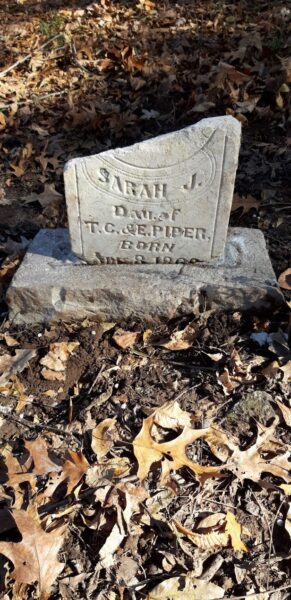
Sarah J. Piper Headstone
American Midwest culture
19th century
Marble, L. 30 cm, W. 6.3 cm x H. 46 cm
Union Campground Cemetery #24
This marble headstone memorializes Sarah J. Piper, who was the daughter of Theophilus Piper and Elizabeth Ellison Piper. She is buried next to her brother, Robert. Both the top and the bottom of Sarah’s headstone are broken off, and and her date of death is missing; however, the partial birthdate indicates that she was born April 8, 1860. The designs on her headstone are very similar to the designs on her brother Robert’s headstone, which has an engraving of a lamb–a motif that suggests that she and her brother were both very young when they passed away. (Researched by Ashley Pitt)
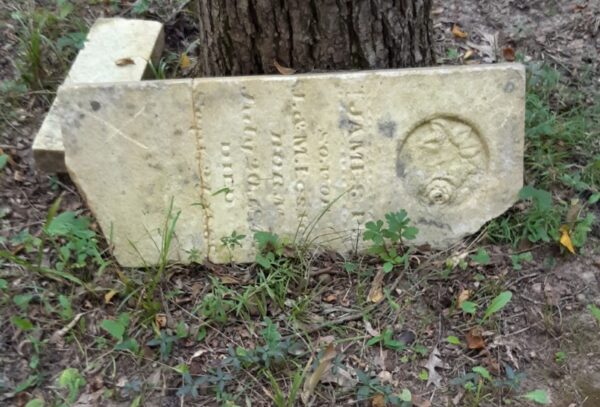
James P. Lester Headstone and Footstone
American Midwest culture
19th century
Marble, L. 31.7 cm x W. 5.1 cm x H. 76.2 cm
Union Campground Cemetery #27
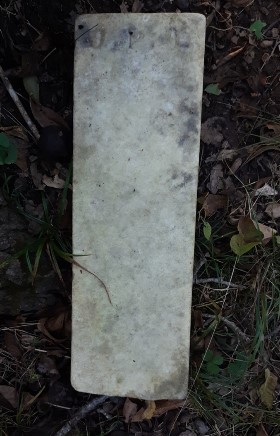
James P. Lester Headstone and Footstone
American Midwest culture
19th century
Marble, L. 31.7 cm x W. 5.1 cm x H. 76.2 cm
Union Campground Cemetery #27
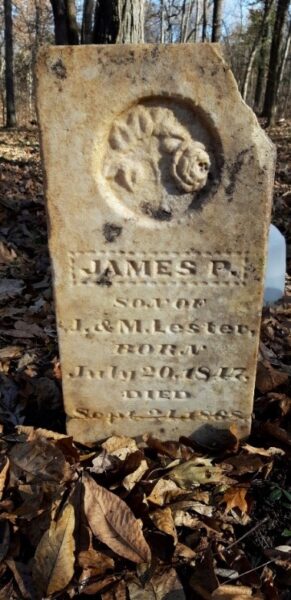
James P. Lester Headstone and Footstone
American Midwest culture
19th century
Marble, L. 31.7 cm x W. 5.1 cm x H. 76.2 cm
Union Campground Cemetery #27
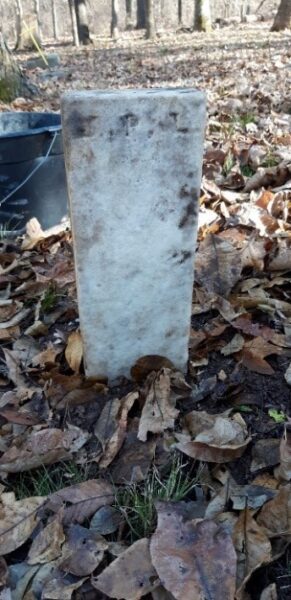
James P. Lester Headstone and Footstone
American Midwest culture
19th century
Marble, L. 31.7 cm x W. 5.1 cm x H. 76.2 cm
Union Campground Cemetery #27
James P. Lester was the son of Joseph and Elizabeth Lester; he was born July 20, 1847 and died at the young age of 21 on September 24, 1868. While James’s grave has relatively simple, rectangular gravestones, both a headstone and footstone made of engraved marble are provided to memorialize his life. The headstone and footstone together resemble a headboard and footboard, suggesting that he was laid in a bed for his eternal rest. (Researched by Ashley Pitt)
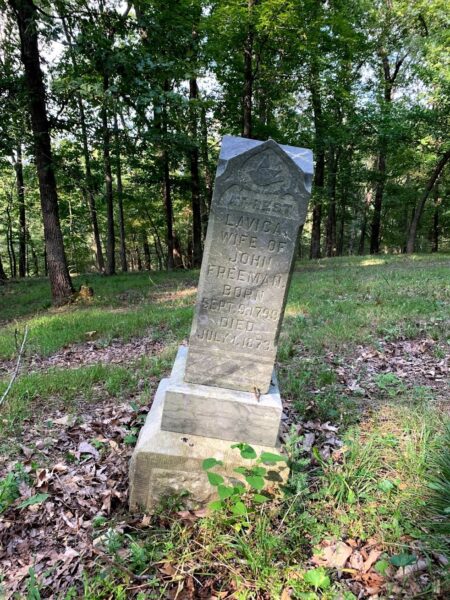
Pedestal with Church Top Obelisk Headstone and Footstone for Lavica Freeman
Midwest American culture
19th century
Marble, L. 41 cm x W. 41 cm x H. 99 cm
Union Campground Cemetery #40
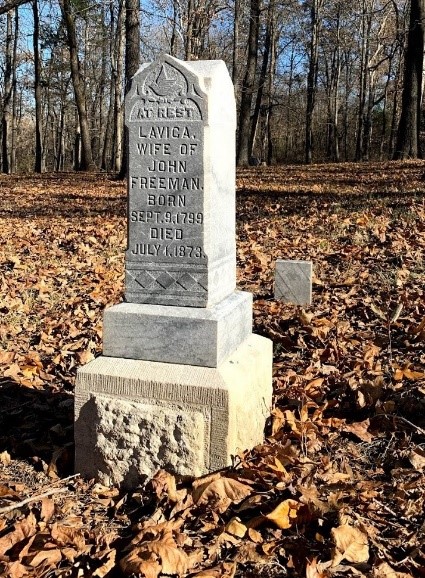
Pedestal with Church Top Obelisk Headstone and Footstone for Lavica Freeman
Midwest American culture
19th century
Marble, L. 41 cm x W. 41 cm x H. 99 cm
Union Campground Cemetery #40
Lavica Freeman is memorialized with an elaborate marble gravestone in the form of a church-top obelisk on a pedestal, along with a simple marble footstone. Obelisks are a form that originates in Egypt, but they have been a popular headstone shape in North America since the 16th century. The shape is both pragmatic and symbolic: The slender shape of an obelisk does not take up take up much square space on the ground, and the obelisk represents the upward movement of the soul to the afterlife. The obelisk is also engraved with images, including a bird in flight, which may symbolize either a spirit flying away or that Freeman has gained a new, non-earthly body; oak leaves, which represent faith and a long life worthy of honor; and the fleur-de-lis, which symbolizes the Christian belief in the Trinity of the Father, the Son, and the Holy Spirit.
Like the other gravestones in the cemetery, Freeman’s grave is oriented so that her head is pointing west, with the headstone behind her head and the footstone at her feet; therefore, if the body were sitting or standing, it would be facing east. This is significant because in Christian theology, when Christ returns from the east, all of the bodies will rise up to face him. (Researched by Katie Kimbrough)
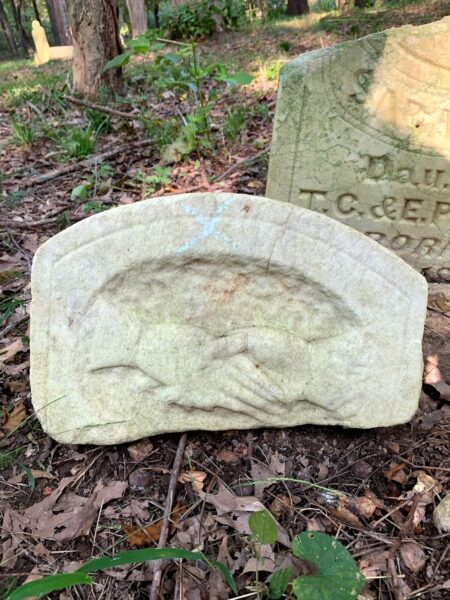
Headstone Top with Handshake Image
Midwest American culture
19th century
Marble, L. 35.2 cm x W. 6 cm x H. 21 cm
Union Campground Cemetery #24+

Headstone Top with Handshake Image
Midwest American culture
19th century
Marble, L. 35.2 cm x W. 6 cm x H. 21 cm
Union Campground Cemetery #24+
This fragmentary monument is the top of a headstone that illustrates the symbol of two hands grasping in a handshake. The symbol of a handshake can hold different meaning based on small details in the depiction. One possible meaning of the handshake motif on a gravestone is that God is greeting the recently deceased Christian into the afterlife. However, because one of the hands in this depiction appears more slender and feminine than the other, the sleeve tapers to a narrow wrist, and the hand appears to be limp, this image most likely represents the handshake of a husband bidding farewell to his deceased wife. (Researched by Katie Kimbrough)
For more information, you may contact the researcher(s) noted in the title of this exhibit entry, or Dr. Billie Follensbee, the professor of the course, at BillieFollensbee@MissouriState.edu

